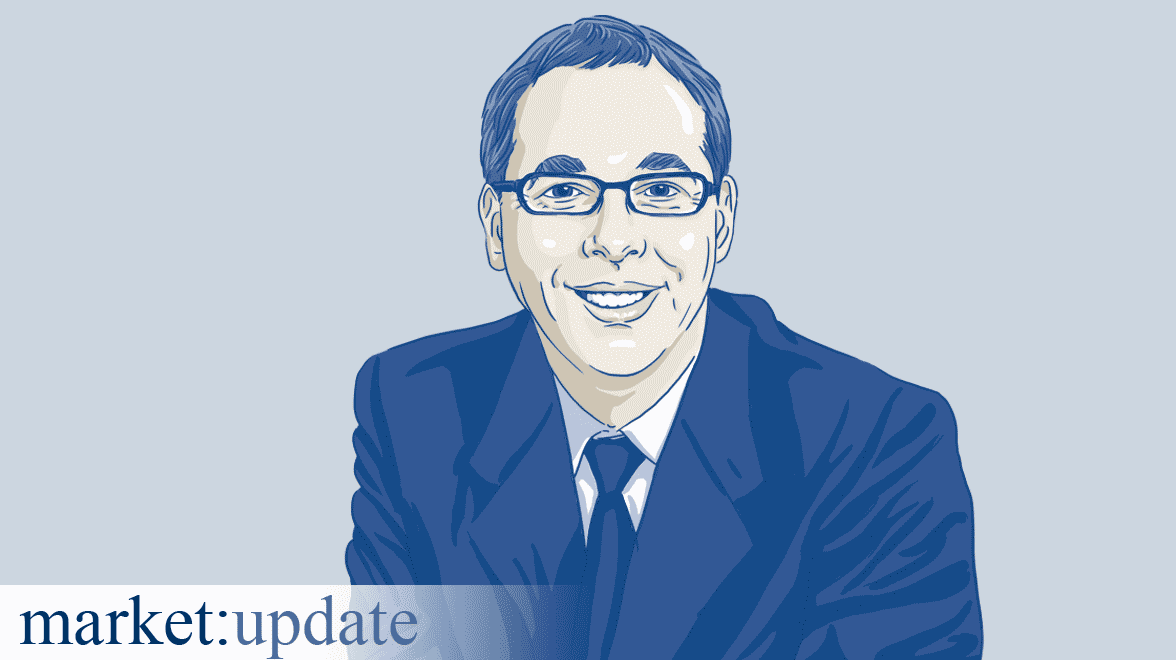Outlook for the 2nd quarter: Key interest rates remain on the rise in Europe and the USA
Bond markets: Despite mini-bank crisis, ECB still in rate hike mode
The mini-bank crisis in the USA and Europe was the dominant event for the bond markets in Europe in the first quarter of 2023. As a result, the financial markets reassessed central bank policy. Before the crisis, the European Central Bank (ECB) was still expected to have a peak key interest rate of 4.0 percent in late summer; after the crisis towards the end of March, the key interest rate peak was seen at only 3.4 percent. Financial markets also expected significant cuts in key interest rates for 2024. Therefore, European government bonds recorded positive performance, while corporate bonds significantly underperformed due to a widening of spreads and fluctuated around the zero mark.
Financial markets assume that the mini-banking crisis will contribute to banks lending less and therefore to a weakening economy. However, the incredibly generous aid from central banks and financial regulators could also mean that banks feel safe and lend more. Economic data in the next few months will show how and to what extent the mini banking crisis is affecting the economy. It is undeniable, however, that inflation is still too high and wage dynamics in the eurozone have accelerated. Thus, the ECB is still in rate hike mode. We foresee another hike of 0.5 percentage points to 3.5 percent in May. Should the economy develop more steadily than expected, further interest rate steps by the ECB could follow. Consequently, we still see risks for rising yields. However, in our baseline scenario, we see noticeable economic weakness from summertime onwards, so we do not expect any more interest rate steps by the ECB after May. In our view, there is even a chance of key rate cuts towards the end of the year. 2023 therefore promises positive performance for government and corporate bonds.
Equity markets: Volatile sideways course ahead!
Positive performance on the global equity markets continued in the first quarter. Key interest rate hikes by the US Federal Reserve and the ECB as well as a mini-bank crisis could not throw the equity markets off track. Due to the mini-bank crisis, yields on the bond markets fell, thus giving a positive impulse to growth stocks in particular. Basically, however, the good economic data from all economic areas, falling inflation rates and stable corporate profit margins formed a sufficiently positive counterweight.
The decisive factor for the outlook for the equity markets will be the economic development of the global economy. Optimists see a noticeable improvement in supply of raw materials and intermediate goods and therefore expect noticeable improvement in the global economy with significantly declining inflation rates. They also see a strong labor market, which will ensure dynamic growth in labor income and thus consumption. In this scenario, no further rise in bond market yields would be expected, as declining inflation would take the pressure off of central banks. The international equity markets would also still have considerable price potential in this scenario.
Pessimists, on the other hand, weight monetary policy higher and already assess the stance of monetary policy as restrictive. They point to the inverted yield curve and the noticeable weakening of lending to the private sector in the USA and Europe. They say restrictive monetary policy slows down economic growth and would not be in line with an acceleration of growth as the optimists expect. Pessimists also point out that the central banks could still implement further key interest rate hikes in the second quarter.
Both camps have good arguments. Prices on the equity markets are therefore likely to continue to move volatilely sideways – as has been the case with the S&P 500 since May of 2022.
Eurozone: Economic recovery and rising core inflation point to further interest rate steps by the ECB
The good economic news from the eurozone continued in the first quarter: business climate indices and consumer confidence improved. Even the rescue of Credit Suisse in dire straits and the ensuing fears of a banking crisis could not stop the economic locomotive in its tracks. At the same time, the risks of a banking crisis in Europe can be classified as low. Since the financial market crisis, banks have held significantly more equity and have significantly lower risks on their balance sheets. According to statements by the ECB, all systemically important banks in Europe would still have enough regulatory capital even if they were forced to sell all securities immediately and realize losses. Liquidity is much more important than solvency for banks. The level of liquidity at European banks is high and they can trust the ECB to provide sufficient liquidity at any time in an emergency.
However, along with economic recovery, an increase in domestically generated core inflation was also observed. In February, core inflation even rose to 5.6 percent. The reason for this seemed to be the strong labor market. Dynamic employment growth, low unemployment and an acceleration of wage growth could be observed. High wage growth even pointed to risks that second-round effects may have become established. Last year, energy prices were the main driver of inflation; this year, wages seem to have taken over this function. The ECB is thus challenged to slow down economic momentum so that core inflation can fall back to 2.0 percent. We expect an interest rate hike to 3.5 percent in May. However, there is a realistic risk that the ECB will have to raise the key interest rate even further afterwards.
We assume that the ECB will be successful and that the economy will weaken noticeably in the second half of the year. There are already several signs of this. Short-term interest rates are higher than long-term interest rates, so financial markets are already pricing in ECB rate cuts in the future, which normally only happens in a recession. There is also already a contraction in lending and money supply, which is very unusual. This will probably continue for the time being since European banks are expected to tighten credit standards noticeably. Without increased lending, there will be no new money and thus no new demand in the private sector. It is only a matter of time before the economy weakens noticeably.
USA: Rising core inflation points to further Fed rate hikes in May
The US economy showed surprising strength in the first quarter. Consumption, for example, recorded a jump of 1.8 percent in January compared to the previous month, and a further increase of 0.3 percent is expected in February. Slight declines were still observed in December and November. However, the positive picture may have been scratched in March: The closure of Silicon Valley Bank and two other banks showed that smaller and medium-sized banks in the US are suffering from a liquidity shortage and are not very crisis resistant. The liquidity shortage is a consequence of the US Federal Reserve's restrictive monetary policy. Investors withdrew their money from banks with an average interest rate on deposits of about 0.5 percent and placed it in money market funds with an average interest rate of about 4.5 percent. Also, the Federal Reserve's balance sheet reduction – i.e. the sale of securities from the Federal Reserve's balance sheet of about USD 100 billion per month – reduced money supply. However, the Fed's liquidity assistance during the banking crisis may have provided a one-time increase in the money supply in March – but in April, money supply is likely to decline again.
The rapid and very generous liquidity support provided by the US Federal Reserve and the quick intervention of financial regulators mean that a systemic banking crisis is not to be expected in the USA. However, due to the turbulence, the smaller and medium-sized banks are likely to restrict their lending in order to secure liquidity. The outcome would be an economic slowdown in the next few months. However, it is also possible that banks will suddenly feel secure due to the generous aid and even expand lending. Loan data in the next few months will show which effect dominates and how strong it is. At the same time, however, core inflation also accelerated, so the Fed could well raise its policy rate to above 5.0 percent in May if economic data remains reasonably stable until then. We expect it to be a close call.
Asia: In Japan there are increasing signs that deflation is coming to an end; China's economy is picking up significantly
Can Japan overcome the deflationary tendencies of the past 20 years? In February, domestically generated core inflation rose to 3.5 percent – a level well above the Bank of Japan's inflation target of 2.0 percent. So far, the Bank of Japan assumes that this is only a temporary surge in inflation: The increased prices for imported energy and raw materials have been reflected in domestic prices. However, this is only a one-off effect. For consistently high inflation, an acceleration of wage growth is necessary; i.e. the emergence of so-called second-round effects. There is no doubt that wage dynamics have accelerated in Japan: In January 2021, trend-adjusted wages still dropped by about 1.3 percent year-on-year; in February 2023, they rose by 1.8 percent. However, for inflation to establish itself at around 2.0 percent, a further increase in wage dynamics to around 3.0 percent is necessary. Only then would the Bank of Japan come under pressure to tighten monetary policy. At least the economic data have been good recently. The purchasing managers' indices even improved noticeably, so the labor market should remain strong and there is still potential for higher wage growth.
Recovery is in full swing in China. Data showed rising industrial production and consumption in the first two months of the year. The real estate market also showed first signs of stabilization. The end of all restrictive covid measures in combination with government aid – especially for the real estate market – seem to have had the desired effects. At the same time, inflation in China is still low. Chinese economic policy makers can therefore adopt a wait-and-see attitude for the time being.
More articles
This document published by Metzler Asset Management GmbH [together with its affiliated companies as defined in section 15 et seq. of the German Public Limited Companies Act (Aktiengesetz – "AktG”), jointly referred to hereinafter as “Metzler“] contains information obtained from public sources which Metzler deems to be reliable. However, Metzler cannot guarantee the accuracy or completeness of such information. Metzler reserves the right to make changes to the opinions, projections, estimates and forecasts given in this document without notice and shall have no obligation to update this document or inform the recipient in any other way if any of the statements contained herein should be altered or prove incorrect, incomplete or misleading.
Neither this document nor any part thereof may be copied, reproduced or distributed without Metzler‘s prior written consent. By accepting this document, the recipient declares his/her agreement with the above conditions.
 Deutsch
Deutsch English
English


